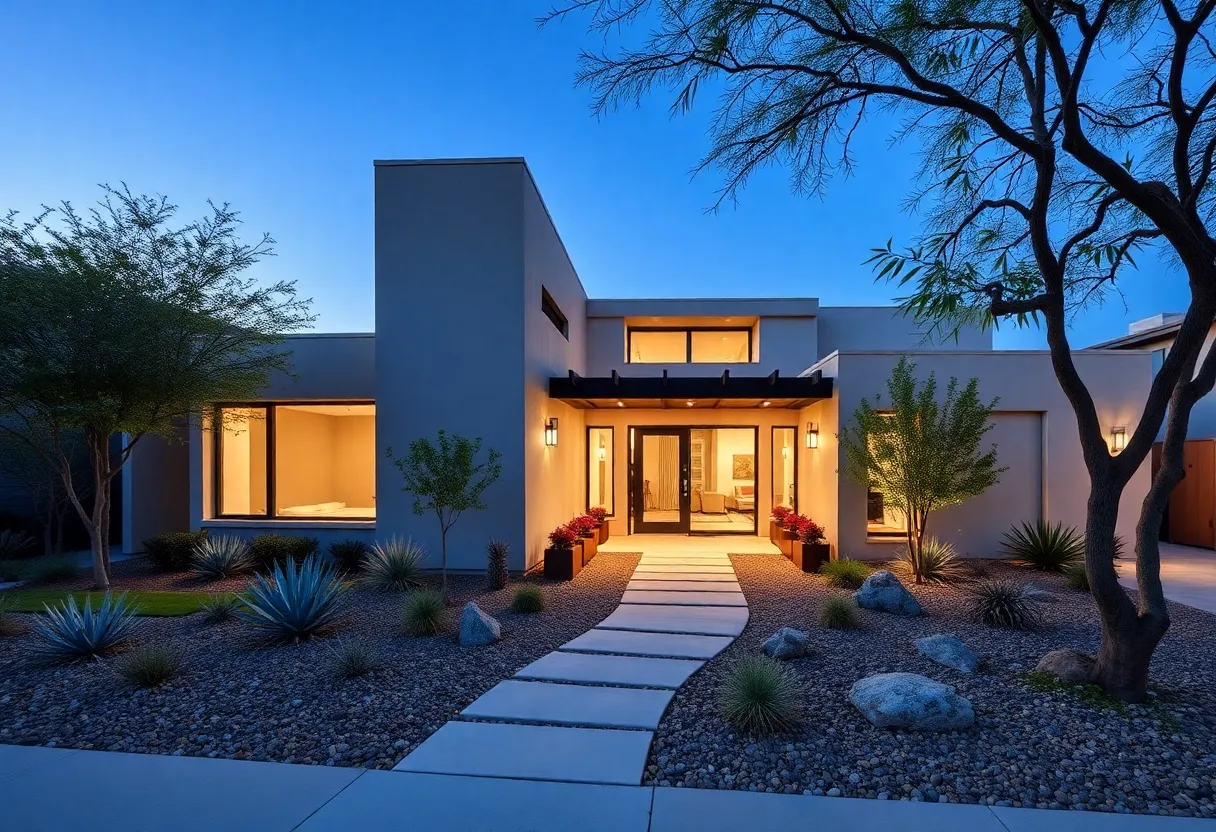How to Optimize Your Phoenix Home Design for Energy Efficiency: Local Tips and Strategies
Maximizing Energy Efficiency in Phoenix Homes: Key Strategies Tailored to the Desert Climate
Understanding Phoenix’s Climate and Its Impact on Home Design
Phoenix experiences extreme heat during most of the year, often exceeding 100°F (38°C). This intense heat influences how homes should be designed and retrofitted to optimize energy efficiency. Homes that are not properly insulated, ventilated, and shaded tend to rely heavily on air conditioning, leading to elevated energy bills and environmental impact. The goal is to minimize heat gain, maximize natural cooling, and reduce energy consumption through targeted design solutions specific to the desert environment.
Effective Insulation and Airtight Sealing: Foundations of Efficiency
Choosing the Right Insulation Materials
Optimal insulation drastically reduces heat transfer between indoor and outdoor spaces. For Phoenix’s hot climate, spray foam insulation is highly recommended because of its superior thermal resistance and ability to air seal at the same time. It fills gaps and cracks, preventing hot air from infiltrating the home. Another beneficial choice is insulated concrete forms (ICFs), which offer excellent thermal mass, helping to stabilize indoor temperatures and decrease reliance on cooling systems.
Sealing Gaps and Leaks for Maximum Benefit
Identify leaks around windows, doors, electrical outlets, and ductwork using techniques like smoke pencils or infrared cameras. Seal these leaks with appropriate products such as caulk and weatherstripping. Proper sealing prevents hot air from sneaking inside and reduces the workload on air conditioning units, translating directly into lower energy costs.
Windows Designed for the Desert: Minimize Solar Heat Gain
Low-E Glass Windows
Installing Low-Emissivity (Low-E) windows can markedly decrease solar heat gain. These windows have a special coating that reflects infrared radiation, keeping homes cooler during the scorching summer months. They allow natural daylight to enter without increasing indoor temperatures, ultimately reducing the load on cooling systems.
Strategic Window Placement and Shading
Orient windows to face north or south where available, minimizing direct sun exposure. Incorporate shading devices like overhangs, pergolas, or shade screens to block high-angle summer sun while permitting winter sunlight to warm the interior. Proper shading design can cut cooling costs by up to 30% in Phoenix.
Roofing and Exterior Surface Innovations for Peak Performance
Cool Roofing Materials
Choose roofing materials with high solar reflectance or high “albedo,” such as reflective coatings, light-colored tiles, or metal roofing. These materials reflect more sunlight, absorbing less heat, and significantly decrease the temperature of the roof surface—an essential step in reducing cooling loads.
Reflective Exterior Walls and Treatments
Apply reflective paints or wall finishes to exterior surfaces. Incorporating insulation in exterior walls further prevents unwanted heat transfer. Additionally, installing awning shades or exterior shading devices can block high summer sun, keeping walls cooler and reducing cooling demand.
Landscaping for Passive Cooling and Energy Savings
Plant Trees Strategically for Seasonal Benefits
Plant deciduous trees on the west and east sides of the property to provide ample shade during the hottest summer months. These trees shed leaves in winter, allowing sunlight to permeate and naturally warm the home. Using mature trees can provide 20-50% shade coverage, significantly lowering indoor temperatures.
Incorporate Green Roofs and Living Walls
Green roofs and living walls insulate buildings naturally. They absorb heat, improve air quality, and provide additional cooling benefits. Although more common in new constructions, existing homes can retrofit with small green features to enhance energy efficiency and aesthetic appeal.
Upgrading Mechanical Systems: Efficiency and Smart Management
High-Efficiency HVAC Systems
Investing in ENERGY STAR-rated HVAC units ensures optimal performance and lower operational costs. Modern systems include variable-speed compressors and advanced filtration, which improve energy efficiency and indoor air quality. Regular maintenance, like changing filters and checking refrigerant levels, is vital to maintain effectiveness.
Smart Thermostats and Zoning
Install smart thermostats that adapt to your schedule and occupancy patterns. These devices optimize cooling cycles and reduce energy waste. Consider zoning systems, which allow different areas of the home to be conditioned separately based on use, further conserving energy.
Harnessing Solar Power and Renewable Technologies
Solar Panel Systems for Phoenix Homes
Phoenix’s abundant sunshine makes solar energy an appealing investment. Photovoltaic (PV) systems can generate a significant portion of a home’s electricity, substantially reducing utility bills. Local incentives, tax credits, and net-metering policies often make solar installations more financially accessible.
Solar Water Heaters and Hot Water Systems
Utilize solar thermal collectors to heat water naturally, decreasing reliance on electric or gas water heaters. These systems provide sustainable hot water solutions, especially beneficial in a sunny climate where heating demands are high.
Water Conservation as Part of Sustainability
Installing Efficient Fixtures
Low-flow showerheads, faucets, and dual-flush toilets cut water use and reduce hot water heating energy. These fixtures are easy upgrades with tangible benefits for energy conservation.
Rainwater Harvesting and Irrigation Optimization
Collect rainwater for landscape irrigation, reducing dependence on municipal water and decreasing the energy associated with water pumping and treatment. Combine rainwater systems with native drought-tolerant plants to optimize landscaping efficiency.
Aligning with Local Building Standards and Passive Design Principles
Compliance with Local Codes and IECC Standards
Adhere to the International Energy Conservation Code (IECC), which provides specific requirements suited to Phoenix’s climate zone. These include minimum insulation R-values, window performance ratings, and ventilation standards.
Passive Design Strategies
Optimize building orientation, natural ventilation, and thermal mass to leverage natural cooling. Techniques such as cross-ventilation, shaded courtyards, and reflective surfaces dramatically reduce dependence on mechanical cooling.
Home Energy Audits: Pinpointing Opportunities
Professional Energy Assessments
Certified auditors provide detailed evaluations using tools like blower doors and infrared cameras. Their insights identify hidden leaks, insulation weaknesses, and inefficient appliances, enabling targeted improvements.
DIY Energy Efficiency Checks
Homeowners can perform basic inspections by examining insulation levels, checking for drafts, and monitoring energy bills. Simple steps like sealing leaks and adjusting thermostats can produce immediate savings.
Local Resources and Incentive Programs Supporting Efficient Homes
City of Phoenix Initiatives and Incentives
Phoenix offers programs to promote sustainable home design, including free access to design resources and informational guidance. These facilitate cost-effective upgrades aligned with local climate needs.
Utility Programs and Rebates
Many utility providers offer rebates for solar installations, energy-efficient appliances, smart thermostats, and insulation upgrades. Engaging with these programs can lower the financial barriers to energy-efficient home improvements.
FAQ
What insulation materials are best suited for Phoenix homes?
Spray foam insulation offers superior thermal resistance and air sealing properties, making it ideal for hot climates. Insulated concrete forms (ICFs) also provide excellent thermal mass, helping stabilize indoor temperatures and reduce cooling demands.
How can I effectively reduce heat transfer through my windows?
Installing Low-E glass windows significantly minimizes heat gain by reflecting infrared rays. Proper window shading, such as overhangs or shade screens, further prevents solar heat from entering during peak hours.
Are there local incentives for energy-efficient retrofits in Phoenix?
Yes, local programs and utility rebates promote energy-efficient upgrades. These include incentives for solar panel installation, high-efficiency HVAC systems, insulation, and smart home devices, making sustainable improvements more affordable.
Key Features of Energy-Efficient Home Design in Phoenix
| Feature | Description | Benefits |
|---|---|---|
| Insulation and Sealing | Use of spray foam and sealing techniques to prevent heat transfer. | Enhanced comfort and energy savings by minimizing heat infiltration. |
| Energy-Efficient Windows | Low-E coatings and strategic placement to reduce heat gain. | Lower cooling costs and improved thermal comfort. |
| Roofing and Exterior Treatments | Use of reflective roof surfaces and wall finishes. | Reduced heat absorption and cooling energy demands. |
| Landscaping | Shade-providing trees and living walls. | Natural cooling, improved air quality, and aesthetic appeal. |
| Mechanical and Control Systems | High-efficiency HVAC units and smart thermostats. | Optimized energy use and lower utility bills. |
| Renewable Energy Integration | Solar PV systems and solar water heaters. | Significantly reduces reliance on grid power and costs. |
| Water and Irrigation Efficiency | Low-flow fixtures and rainwater harvesting. | Conserved water resources and reduced energy for water heating. |
| Passive Design Principles | Orientation, natural ventilation, and thermal mass. | Reduced dependence on mechanical cooling and heating. |
| Energy Audits | Professional and DIY evaluations to spot inefficiencies. | Targeted upgrades lead to maximum savings. |
| Local Resources and Incentives | City and utility programs supporting sustainable upgrades. | Financial benefits and access to expert guidance. |
Author: STAFF HERE PHOENIX WRITER
The PHOENIX STAFF WRITER represents the experienced team at HEREPhoenix.com, your go-to source for actionable local news and information in Phoenix, Maricopa County, and beyond. Specializing in "news you can use," we cover essential topics like product reviews for personal and business needs, local business directories, politics, real estate trends, neighborhood insights, and state news affecting the area—with deep expertise drawn from years of dedicated reporting and strong community input, including local press releases and business updates. We deliver top reporting on high-value events such as the Waste Management Phoenix Open, Cactus League Spring Training, and Arizona State Fair. Our coverage extends to key organizations like the Greater Phoenix Chamber of Commerce and Visit Phoenix, plus leading businesses in technology and healthcare that power the local economy such as Intel and Banner Health. As part of the broader HERE network, including HERETucson.com, we provide comprehensive, credible insights into Arizona's dynamic landscape.





